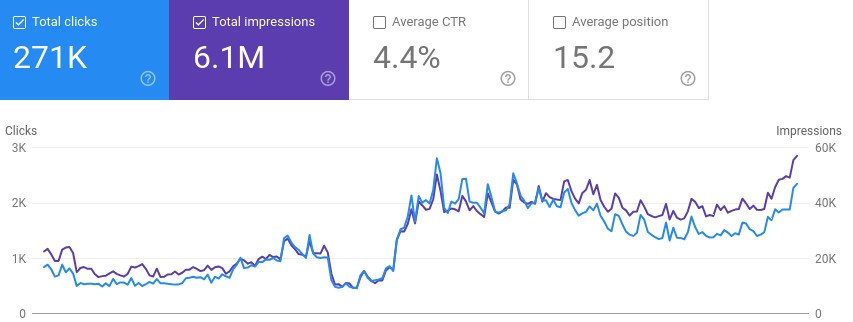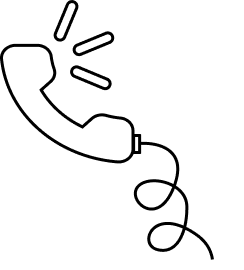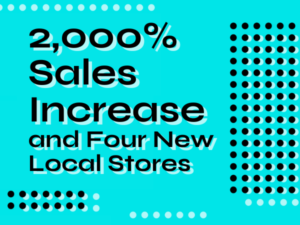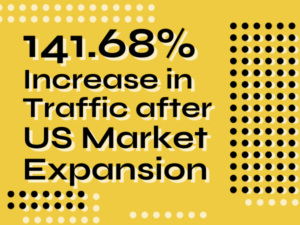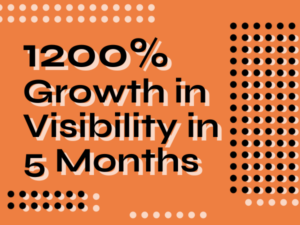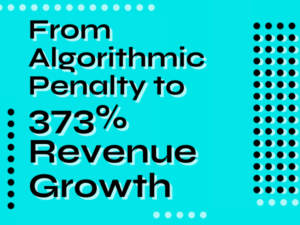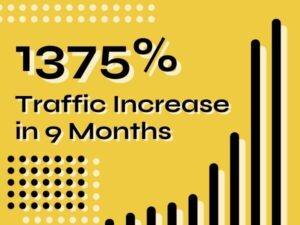From Algorithmic Penalty to 373% Revenue Growth | Home & Garden Niche
Curious to see how we managed to recover the client’s website from an algorithmic penalty and grow the revenue multiple times by further improving the page and expanding to a new market?
In this case study, we recount our journey from recovering a client’s website from an unexpected Google algorithmic penalty to achieving a breathtaking 373% growth in revenue within just a few months.
We didn’t just fix the most burning issues and implement standard content and link strategies.
This time, we helped the client to expand to a new market, with a comprehensive Spanish version of their site reaching a previously untapped (global!) audience.
The website's revenue surged to $3,162, marking a peak increase of 373% compared to the initial declining figures.
The website experienced a significant 55.96% growth in sessions, translating to an increase of 92,768 visitors.
The website also saw a 56.09% growth in new users during the same period, which represents 81,689 additional new users arriving at the site.
Overall user numbers were up by 57.77% year-over-year (3-month period), equating to an uplift of 83,444 users.
The team set out to diagnose the algorithmic penalty's causes and implement targeted recovery tactics to restore traffic and ad revenue. Part of this objective involved an ongoing assessment of the impact of implemented measures and adjustments based on the evolving search algorithm landscape.
Actionable issues identified through the SEO audit, like getting rid of duplicate content and enhancing site speed, were addressed to improve technical SEO. The team remained committed to re-evaluating and optimizing these enhancements as new insights and performance data became available.
The team aimed to create a foundation for growth through keyword opportunity identification, strategic content creation, and effective link-building practices. As the project progressed, the approach was refined in response to the keyword ranking movements and link-building results, ensuring the growth plan remained dynamic and data-driven.
Aiming to tap into the Spanish-speaking market, the team introduced a Spanish website version using AI-powered programmatic SEO backed up with WPML for efficient translation and content management. The performance of the Spanish content was continuously monitored, and the efficacy of the translated content was evaluated periodically to determine areas for improvement.
The site's rapid decline in traffic right after acquisition raised immediate concerns about a potential algorithmic penalty by Google – or a negative SEO attack. It required immediate investigation. Assessing the situation involved sifting through backlink profiles and traffic data amidst a series of recent Google algorithm updates.
The SEO audit revealed a series of technical issues, including duplicate content, slow page speeds, and lackluster site structure. Each issue required a tailored solution, from removing duplicate content to optimizing images for speed improvements.
A sudden surge in low-quality backlinks hinted at a possible negative SEO attack, threatening the site's credibility with search engines. Deciding on an effective response strategy was a complex process. It involved the use of disavow tools and manual link scrutiny without negatively impacting genuine backlinks.
Beyond penalty recovery, the project aimed to not only regain lost ground but also expand organic reach, which required innovative strategies. The development of new content targeted at untapped keywords and audience segments involved substantial resource investment and risk.
Conducted an in-depth SEO audit to pinpoint technical SEO issues and crafted a strategic recovery plan to address the suspected algorithmic penalty. Fixed issues related to essential technical SEO elements and improved site efficiency, focusing on duplicate content, site indexation, and overall site health.
Formulated a robust content strategy paired with high-quality, SEO-focused copywriting to recover rankings and capture new keyword opportunities in the broad Home & Garden niche. Executed strategic link-building campaigns to improve the site's authority in the Home & Garden niche and optimized site structure for improved navigation and search engine indexing.
Reevaluated the monetization strategy of the client’s website and proposed new ways to diversify the revenue stream. Optimized ad placements in order to maintain compliance with Google Ads policies and increase the potential revenue streams, and implemented affiliate marketing segments, further enriching the user experience.
Launched a Spanish version of the site to target a wider audience, employing SEO best practices tailored to the Spanish-speaking market. Implemented a technical framework for content translation and integration, further establishing the website's presence in new linguistic demographics.
Home & Garden is a welcoming niche that usually promises stable traffic and a dedicated audience interested in everything from landscaping to decor.
The niche gathered a lot more attention during the pandemic – thanks to the overall increase in DIY in the stay-at-home time – and has maintained the velocity since.
This is probably why our client decided to acquire an already-established content website focused on this topic.
With our help, the website grew over five times in revenue in just five months. But it wasn’t so smooth from the start.See what caused the initial downturn, how we identified the critical issues, and the multi-level strategy we implemented to not only recover but also greatly enhance the site’s performance.
The Client
Our client had bought a website focused on Home & Garden content. They were excited about the purchase, and expected to benefit from the site’s established traffic and passive income.
However, soon after the purchase, the site’s traffic tanked dramatically, leading to a steep decline in revenue. This suggested that the site might be affected by a Google penalty – a serious concern for the new owner.
Facing this urgent issue, the client reached out to us for help.
They needed a thorough investigation into the problem and an effective solution to not only recover the lost traffic and revenue, but also secure and grow the site’s market position for the future.
Project Timeline: How We Saved Our Client From a Google Penalty
The problem was evident, so we needed to take care of it ASAP.
Only when we learned what needed to be done, we devised a full-on strategy – dividing the project into three phases. Let’s go through each of them.
Phase 1: Comprehensive SEO Discovery
We usually say that no two SEO campaigns are the same. The process, however, is typically quite similar for most of them. So, we started with an in-depth audit, following the PDCA cycle.
First Step: SEO Audit
We started by crawling the client’s website with Sitebulb to uncover any technical problems there. At this point, we found a few glaring issues.
Duplicate contentDuplicate content may not sound like a big deal, but it can cause search engines to get mixed signals about which page to prioritize. This can lead to lower rankings for both pages in the search results. To handle it, our team worked to identify and resolve all occurrences of duplicate content across the site.
This wasn’t just a matter of deleting redundant pages. We had to decide whether to redirect, canonicalize, or adjust the content to be unique. By doing so, we effectively increased the site’s performance.
Missing or Broken Meta ElementsImages with missing alt texts, duplicate headings, and incomplete meta descriptions all contributed to the site’s downfall in search rankings. Our next step involved a detailed sweep to correct these errors.
We didn’t need to reinvent the wheel here. Conversely, we followed a simple process:
- First, we listed the affected sites.
- Second, we determined if Google looked for those meta elements.
- Finally, we added or fixed them where needed.
Insufficient Page SpeedThis wasn’t the biggest issue, but the audit showed that we could easily take it from just decent to great.
With the help of a few plugins – including one that let us make images much lighter – we lowered the loading speed by at least a second. This increased the website’s PageSpeed rank from 75 to 90 and, in addition, let us pass the Core Web Vitals tests!
Site Structure and IndexationOriginally, the website’s content was divided into only five categories. Considering that it already had 530 articles, the issue was clear. Google saw it this way, too. It just wasn’t interested in all the content.
To correct this, we added 20 more categories (and expanded them by another 35 in the later phase of this project). Thanks to this well-developed navigation, we managed to fix most indexation issues, making it appear in search not soon after!
Second Step: Penalty Analysis
The audit allowed us to get the website back up on its legs, but we were still missing out on keywords – and, thus, traffic.
This was likely a result of two separate (but not entirely unrelated) events.
Not long after the client acquired the website, it gained almost 600 new referring domains.
This is very unusual in such a short time frame. When building links, you aim to build links in a steady and linear fashion – just like it was before.
The bump, however, was likely meant to hurt the website’s authority. Especially considering that most of them came from (blatantly) toxic websites.
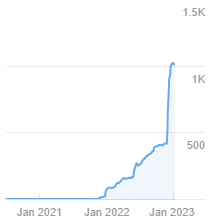
We also took note of Google Algorithm updates – and if you look at the traffic graph below, you can clearly see when they happened.
The problem with core algorithm updates is that there never is just one thing to fix. Instead, you need to keep improving your website to maintain the required quality.
The first set of improvements we implemented revolved around correcting a few more minor technical issues and enriching the content with extra elements such as FAQ and Key Takeaways sections or improved summaries.
The result? We slowly moved back on track!

Phase 2: The Growth Plan
The recovery was just the beginning of this project. Next, we laid the groundwork for long-term growth. We transitioned seamlessly from recovery mode into an ambitious growth strategy tailored to the renewed strength of the now-healthy site.
Again, we applied the same process to a new strategy.
In it, we began by conducting thorough keyword research. We focused on uncovering new opportunities and high-potential keywords that weren’t yet fully covered by the client’s website.
Based on this keyword research and previous data, we crafted a content plan and devised a link-building strategy.
Links and Content: SEO Strategy Implementation
As we mentioned above, the process started with an analysis rooted in the data harvested from Ahrefs. The objective was clear: to pinpoint keywords that, while ranking lower down the search results (positions 11-20), had the potential for rapid growth and created new opportunities.
For content, our strategy relied on optimization with the NeuronWriter app, given its cost-efficiency and built-in AI capabilities. This content was made to rank well!
As the newly optimized content rolled out starting in February, we went on to fortify the website’s domain authority with links. We set three main goals:
Starting in Month 5, our strategies began to bear fruit. The site was no longer just recovering; it was thriving and expanding. We managed monthly additions of 10 high-quality, keyword-optimized posts and 5-10 links.
Additional Monetization
The site was making money only with display ads. This is a completely valid way to generate passive income, but in the case of this website, it was doing this poorly. So, we decided to optimize this as well.
First, we reorganized the way the ads were set up on pages. Too many ads can result in a penalty from Google, as well as a poor viewing experience and a lower click-through rate.
After optimizing ad placements, we looked into diversifying the revenue streams. Adding affiliate links was a no-brainer. Given the site’s content theme, products related to home and garden were a natural fit.
Implementing affiliate marketing through Amazon has already proved to be a smart move. We installed the AAWP plugin for WordPress, which made it super easy to include Amazon product boxes within our articles.
These weren’t intrusive. Instead, they fit naturally into the content, providing value to the readers and encouraging clicks.
Beyond ads and affiliate marketing, we also brainstormed other ways to boost income and came up with options that would be best for the site’s long-term growth. This included direct ad sales, upselling/cross-selling, drop-shipping, or even opening a YouTube channel.
Spanish SEO Expansion – NoN Agency’s Unique Service
Parallel to the main growth plan, we looked for alternative options for expanding the client’s website.
Considering that the website’s primary target was the US, we decided to open it to the second most-spoken language there, Spanish.
- English: 245 million speakers (~78%)
- Spanish: 41 million speakers (~13%)
- Chinese (including all varieties): 3.5 million speakers (~1.1%)
On top of that, with over 500 million people speaking Spanish globally, this choice was a no-brainer. It opened the way to other markets in the Americas and the EU.
The plan was simple: download all the content on the website, translate it, and upload it back, connecting every post in Spanish with its respective English version.
Rad PaluszakHow did we approach translating this many articles?
Doing it manually would take a long time, so we opted for an automated solution.
Of course, there are a few plugins and services that do something similar, but they also require a lot of time and effort to finalize the translation for the whole site.
For example, most plugins like WPML, Polylang, or TranslatePress would require you to click something approximately a gazillion times to complete translating 700 articles. On top of that, they often want you to use their overpriced API (wink, wink, WPML 😉…) and struggle with “string translations,” dumping thousands of them at you.
In case you were wondering why not just install WPML and have it do all the work – here’s why our service is supreme to WPML: we do EVERYTHING for you – pages, posts, categories, strings, tables, meta tags, URL structure, interlinking (which is a big one!) and shortcodes. You just receive the ready product.
So, instead, we built our own automation based on the WordPress REST API and our choice of AI translation API that is fast, accurate, and fairly priced.
CTO at NoN Agency; architect and creator of the NoN Translation Module
Now, a little plot twist (and additional bonus!) for you: as we would rather not develop our own plugin for multilingual websites on WordPress’ side of things, we still decided to go with WPML as the baseline.
Unfortunately, it required additional manual work from us and lacked the REST endpoints we needed and had to create manually. However, it was still much better than developing our own plugin from scratch. And, whatever we say about it, WPML is still very reliable.
It took us a few days to develop and test the solution, and a few hours to have the whole site completely translated.
After all the translation work was done, we were far from finished refining everything. It simply would not be wise to leave it unedited by humans.
That’s why we then took those machine-translated texts and started a gradual proofreading process with our native content writers. This makes sure the content didn’t have any grammatical errors or awkward phrasing.
As this takes quite a bit of time, we planned to have all articles processed and polished over the coming few months. But in the first three months after launch, the Spanish version with over 700 translated articles has generated over 5,000 clicks and 200,000 impressions!
The results speak for themselves. The additional Spanish content boosted the site’s visibility, attracting a new audience segment that was previously untapped, contributing significantly to the revenue increase.
Key Results from Our Case Study
Let’s look at some hard numbers to showcase the impact of our efforts:
- Revenue Growth: The website experienced a 373% increase in ad revenue, climbing from $669 to $3,162 in just five months.
- Traffic Uplift: Site sessions jumped by 55.96%, amounting to an additional 92,768 visits over a 3-month period
- New User Acquisition: We saw a 56.09% increase in new users, translating to 81,689 more people visiting the site over the same period.
- Overall User Increase: The total user count rose by 57.77%, with 83,444 new visitors exploring the site.
- Spanish Expansion Success: The Spanish version alone generated over 5,000 clicks and 200,000 impressions, contributing an estimated $400 in extra revenue.
- Content Production: Over the project period, we published 10 new, optimized posts per month, totaling over 50 highly ranked articles.
- Link Building Progress: We managed to secure 5-10 high-quality backlinks each month, significantly boosting the site’s domain authority and search.
Total traffic level throughout the project. You can see when the penalty hit and when we got the website back on track.
Case study created by:
Co-Founder & CTO
This case study was a unique SEO rollercoaster. Starting with a penalized site, we navigated through challenges, identified opportunities, and five-folded the revenue in less than a year.
The Spanish version of the site was definitely the highlight of the project. By opening to the Spanish-speaking market, we opened doors to over 500 million potential new users – and many new opportunities.
Ready for your own success story?
Reach out to us, and let us steer your website towards growth. Together, we can turn the tides in your favor.





